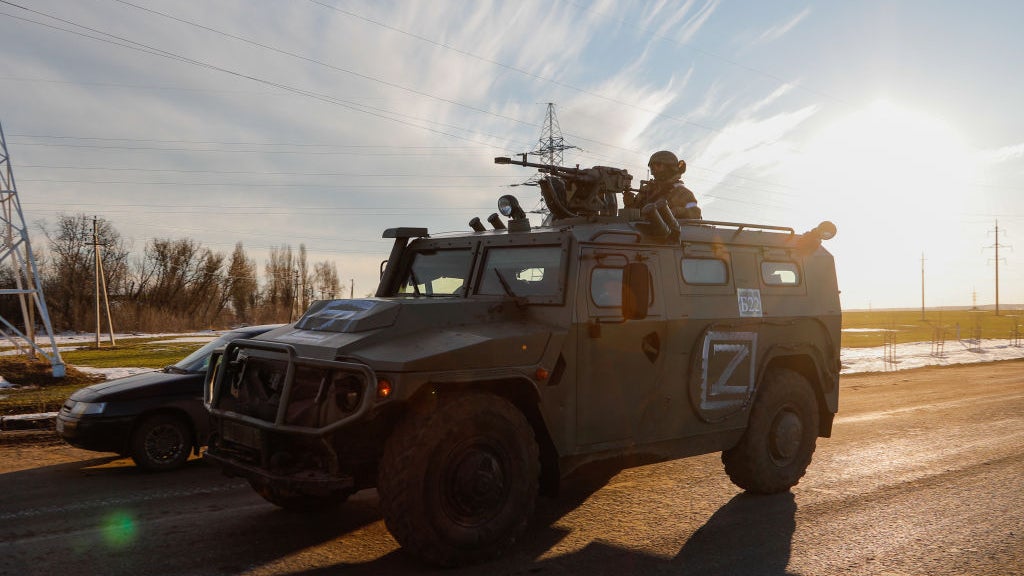Experts have said the series of disinformation, from hoax videos to unfounded claims of "genocide" and nuclear arms, that appeared online weeks before the conflict began are an integral part of Russia's war on Ukraine.
Russia’s declaration of war on Ukraine was made clear with its invasion of the country early Thursday, following days of warnings and possible signs that such a move was on the horizon. But Russia’s campaign against their neighboring country began weeks ago in the form of disinformation, experts have said.
In an address to the nation earlier this week, Russian President Vladimir Putin put forth a series of justifications for an invasion, which seemingly set a pretext for events that unfolded later in the week.
But these claims – from false accusations that Ukraine is forming a nuclear arsenal to baseless claims that ethnic Russians within Ukraine’s borders are undergoing a “genocide” – have been slowly circulating for the last several weeks.
Many believe the misleading videos and disinformation may be part of a deliberate plot by the Russians against Ukraine.
Below, Inside Edition Digital explores some of the many elements of disinformation in Russia’s campaign against Ukraine and how they have been debunked.
Russia’s False Claims of the Ukrainian Army Committing Genocide
Putin discussed at length during a televised address earlier this week a “genocide” that is allegedly occurring in the Donbas region of eastern Ukraine, claiming that ethnic Russian residents are being subjected to state-sponsored violence.
“What is happening in the Donbas today is genocide,” Putin said, according to The New York Times.
“The so-called civilized world … prefers to ignore it as if there were none of this horror, genocide that almost four million people are being subjected to,” the address continued, according to an English translation by BBC News.
The same allegations of “genocide” have been echoed by other senior Russian officials and the state media, and a document issued by Russian diplomats to the United Nations Security Council accused Ukraine of “exterminating the civilian population” in the state, The New York Times reported.
However, there is no evidence any genocide is occurring.
German Chancellor Olaf Scholz responded to the claims, calling any allegations of genocide in Ukraine “ridiculous,” Reuters reported.
“There’s just no evidence that any of this exists,” disinformation expert Nina Jankowicz of the Wilson Center explained ahead of Russia’s official declaration of war, according to PBS. “And it strains credulity that, after eight years of war, the Ukrainian army would choose this moment, with 190,000 Russian troops on its borders, to pick up a new aggressive offensive.”
The same claims were used to justify Russia’s 2014 annexation of Crimea.
Blaming Ukraine for an Attack on a Ukrainian Kindergarten Class
Last week, Fairytale Kindergarten in a remote Ukrainian town near the Russian border was hit with shelling. Three adults suffered concussions but thankfully no children were harmed, according to the Washington Post, citing the Ukrainian military.
Ukrainian officials said the kindergarten was attacked by Russian-backed separatists, while those separatists accused Ukrainian government troops of launching the attack.
Jankowicz said that Russia’s blame on Ukraine for the shelling was a “pretext” for their allegations of Russian-speaking Ukrainians under attack, according to PBS.
False Claims That Ukraine Has Nuclear Arms
Putin claimed that “Ukraine intends to create its own nuclear weapons, and this is not just bragging,” later adding that the U.S. has plans to help Ukraine in its mission, The New York Times reported.
Ukraine does not have the infrastructure to build a nuclear arsenal today, and American officials have reportedly stated they will not give Ukraine any nuclear arms, according to the outlet.
Ukraine did once have a nuclear arsenal, which caused it to briefly be the third-largest nuclear power in the world. The arms were left on their territory by Moscow during the Soviet era, and the newly independent country gave up its arsenal in the 1990s, according to NPR.
In exchange, the U.S., U.K. and Russia were meant to guarantee its security in what is known as the Budapest Memorandum.
Videos Circulating Social Media
As videos of false news reports, tanks and soldiers appeared on social media, Twitter users were just as quick to debunk them.
What some falsely described as a video of soldiers “speaking Polish” and sabotaging Russian tanks was later found to be a montage of audio edited to old video footage of Finnish military exercises, according to France 24.
After videos of what some claimed to be Ukrainian tanks advancing into Russian territory surfaced, military equipment experts identified the armored vehicles as a piece of Soviet-era equipment Ukraine does not own, the outlet reported.
Other military experts were also quick to debunk the videos claiming to show shells fired from Ukrainian territory destroying a Russian outpost on the border, instead saying that based on the known locations of Russian outposts, it isn’t possible for that level of damage to be caused by any Ukrainian weapons, France 24 reported.
There had also been videos depicting military drills, some that even looked like news reports, that Agence France-Presse Fact Checkers found to have been footage of unrelated military drills from years before.
Some experts pointed out that the same tactics of social media propaganda were used by the Russians in the 2016 Presidential Election in the U.S.






